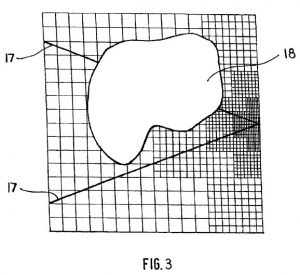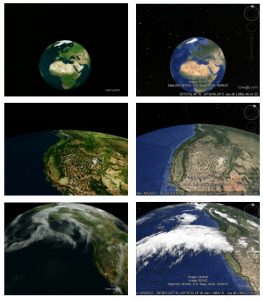On Friday, October 20th, the Court of Appeals for the Federal Circuit entered a non-precedential decision in Art+Com Innovation Pool GmbH v. Google LLC, which affirmed a lower court’s invalidation of a patent covering methods of displaying geographic information to a user. The patent, issued in 2013 to Berlin-based Art+Com Innovationpool and claiming a priority date of December 1995, had been asserted in a patent case decided in the District of Delaware in which the German-based patent owner was seeking more than $100 million from Google for infringement committed by its Google Earth service.
 The patent invalidated by the Delaware court was U.S. Patent No. RE44550, titled Method and Device for Pictorial Representation of Space-Related Data. It claims a method of providing a pictorial representation of space-related data of a selectable object, the representation corresponding to a view of the object by an observer with a selectable location and a selectable direction of view. The method involves providing a plurality of spatially distributed data sources for storing space-related data; determining a field of view including an area of the object to be represented; requesting data for the field of view from the spatially distributed data sources; centrally storing the data for the field of view; representing the field of view data in a pictorial representation having one or more sections; dividing sections with image resolutions less than a desired resolution into smaller sections and requesting higher resolution data to be centrally stored; and repeating this last step until every section has the desired image resolution. The resulting invention improved upon conventional systems for visualizing geographic data which could not provide an image generation rate sufficient upon the alteration of an observer’s location or viewpoint, useful for creating the impression of the continuous movement of the observer.
The patent invalidated by the Delaware court was U.S. Patent No. RE44550, titled Method and Device for Pictorial Representation of Space-Related Data. It claims a method of providing a pictorial representation of space-related data of a selectable object, the representation corresponding to a view of the object by an observer with a selectable location and a selectable direction of view. The method involves providing a plurality of spatially distributed data sources for storing space-related data; determining a field of view including an area of the object to be represented; requesting data for the field of view from the spatially distributed data sources; centrally storing the data for the field of view; representing the field of view data in a pictorial representation having one or more sections; dividing sections with image resolutions less than a desired resolution into smaller sections and requesting higher resolution data to be centrally stored; and repeating this last step until every section has the desired image resolution. The resulting invention improved upon conventional systems for visualizing geographic data which could not provide an image generation rate sufficient upon the alteration of an observer’s location or viewpoint, useful for creating the impression of the continuous movement of the observer.
Art+Com first filed a suit for patent infringement against Google in February 2014. In an amended complaint filed that March, Art+Com alleged that the ‘550 reissue patent claims an invention which was reduced to practice by the inventors in a medium known as Terravision, a networked virtual representation of the earth based on satellite images, aerial shots and altitude and architectural data. “Terravision was the first system to provide a seamless navigation and visualization in a massively large spatial data environment,” Art+Com’s complaint reads.
Terravision’s first implementation utilized Onyx computers developed by Silicon Graphics, Inc., as those computers were the most powerful available at that time for processing and displaying graphical data. At the time that Art+Com worked with Silicon Graphics, the latter company employed two people who would go on to work in executive roles at Google: Michael Jones, who served as chief technology officer of Google Earth between 2008 and 2015; and Brian McClendon, VP of engineering at Google between 2004 and 2015. Art+Com alleged that both Jones and McClendon were both aware of Terravision and generally familiar with its capabilities, Jones in particular having access to proprietary information involving the system.
 In 2001, both Jones and McClendon were allegedly working with Keyhole Inc. to advance geospatial data visualization work that had begun at Silicon Graphics. Keyhole developed a product known as Earth Viewer prior to Google’s acquisition of Keyhole in late 2004. Art+Com’s complaint includes screenshots of Terravision from 1996 alongside screenshots of Google Earth from 2014 to show the similarities between the two systems.
In 2001, both Jones and McClendon were allegedly working with Keyhole Inc. to advance geospatial data visualization work that had begun at Silicon Graphics. Keyhole developed a product known as Earth Viewer prior to Google’s acquisition of Keyhole in late 2004. Art+Com’s complaint includes screenshots of Terravision from 1996 alongside screenshots of Google Earth from 2014 to show the similarities between the two systems.
 In 2006, Art+Com entered into an email conversation with Google over the Terravision technology and Jones even visited Art+Com’s German facilities to discuss licensing or patent acquisition; Google was defending against a patent suit filed against Keyhole before its acquisition and viewed the Terravision technology as useful for defense in that suit. On July 17th, 2006, Google defense lawyer Michelle Lee, who would go on to be the Director of the U.S. Patent and Trademark Office under President Barack Obama, sent an e-mail to Art+Com stating that the Terravision IP was a “nice-to-have patent” and expressed interest to take a deposition from the lead inventor by mid-August. However, Art+Com was not willing to sell the patent for the price offered by Google at that time and ceased communications with Google in December 2007; Art+Com also filed for the reissue patent at this time. After reissue, Art+Com contacted Google in July 2010 regarding the reissue patent and the suggestion “that Google Earth may require a license under the patent.” Many of the infringing elements of the Google Earth system were incorporated into Google Maps which was released in 2014 and Art+Com alleged that Google’s infringement of the reissue patent was willful given their knowledge of both it and Art+Com’s claims.
In 2006, Art+Com entered into an email conversation with Google over the Terravision technology and Jones even visited Art+Com’s German facilities to discuss licensing or patent acquisition; Google was defending against a patent suit filed against Keyhole before its acquisition and viewed the Terravision technology as useful for defense in that suit. On July 17th, 2006, Google defense lawyer Michelle Lee, who would go on to be the Director of the U.S. Patent and Trademark Office under President Barack Obama, sent an e-mail to Art+Com stating that the Terravision IP was a “nice-to-have patent” and expressed interest to take a deposition from the lead inventor by mid-August. However, Art+Com was not willing to sell the patent for the price offered by Google at that time and ceased communications with Google in December 2007; Art+Com also filed for the reissue patent at this time. After reissue, Art+Com contacted Google in July 2010 regarding the reissue patent and the suggestion “that Google Earth may require a license under the patent.” Many of the infringing elements of the Google Earth system were incorporated into Google Maps which was released in 2014 and Art+Com alleged that Google’s infringement of the reissue patent was willful given their knowledge of both it and Art+Com’s claims.
Art+Com’s claims for patent infringement were undone, however, by a verdict issued by the Delaware jury in the case in May 2016. The jury not only found that Art+Com did not prove infringement of the asserted claims but that the asserted patent was anticipated by public use of the system prior to the December 1995 priority date.
In affirming the district court, the Federal Circuit found against Art+Com’s arguments that Google did not provide clear and convincing evidence that the invention of the asserted claims were put into public use. Google’s argument on this point revolved around a 1994 recording of a lecture given by Stephen Lau, then of the Stanford Research Institute (SRI), on a geographical visualization system known as SRI TerraVision. Lau also gave testimony during the Delaware trial on the operation of the SRI TerraVision system. Google also brought an expert witness who gave his opinion that the SRI TerraVision system anticipates the asserted claims.
Art+Com argued that Lau gave vague testimony on the system’s operation which Google didn’t corroborate and that the expert witness “cherry-pick[ed]” excerpts of Lau’s testimony to “stitch together the claimed invention.” Art+Com further stated that the expert witness’ opinion didn’t demonstrate that SRI TerraVision disclosed every claim limitation and that Google failed to demonstrate that the SRI system was “ready for patenting” under a standard set by the U.S. Supreme Court in its 1998 decision in Pfaff v. Wells Electronics, Inc.
The Federal Circuit judicial panel sitting on the case found none of these arguments persuasive. The opinion, penned by Circuit Judge Kathleen O’Malley with Circuit Judges Alan Lourie and Richard Taranto concurring, stated that Lau’s testimony was properly corroborated by both documentary and videographic evidence, including the 1994 video recording and papers authored by Lau on SRI TerraVision’s operation. Art+Com also argued that Lau’s testimony was biased because of compensation from Google on his consulting work but this was evidence that was freely weighed by the Delaware jury.
As to SRI TerraVision not disclosing all claim limitations, Art+Com argued that Google did not present substantial evidence to show that steps involving the division of a parent node into child nodes, recited by claim one of the ‘550 reissue patent, were implemented in SRI TerraVision. The Federal Circuit, however, found that evidence presented by Google showed that the SRI system performed a “coarse-to-fine” zoom action required by claim 1. Art+Com had presented evidence from a draft technical paper on the SRI system on incremental retrieval of data from a database in a way that didn’t practice steps of claim 1.
The “ready for patenting” argument was nixed by the Federal Circuit when it applied the standard it created in Invitrogen Corp. v. Biocrest Manufacturing. This case, decided by the Federal Circuit in 2005, adjusted SCOTUS’ “ready for patenting” standard from Pfaff. Under this standard, “ready for patenting” was satisfied by Lau’s 1994 demonstration TerraVision despite Art+Com’s arguments that SRI had identified several research issues at that time which had yet to be resolved.
The federal judiciary is not the only avenue which Google has taken in its attempts to invalidate the ‘550 reissue patent. This patent was the subject of two petitions for inter partes review (IPR) filed by Google with the Patent Trial and Appeal Board (PTAB). Both of those petitions were procedurally dismissed prior to an institution decision.

![[IPWatchdog Logo]](https://ipwatchdog.com/wp-content/themes/IPWatchdog%20-%202023/assets/images/temp/logo-small@2x.png)


![[Advertisement]](https://ipwatchdog.com/wp-content/uploads/2024/04/Patent-Litigation-Masters-2024-sidebar-early-bird-ends-Apr-21-last-chance-700x500-1.jpg)

![[Advertisement]](https://ipwatchdog.com/wp-content/uploads/2021/12/WEBINAR-336-x-280-px.png)
![[Advertisement]](https://ipwatchdog.com/wp-content/uploads/2021/12/2021-Patent-Practice-on-Demand-recorded-Feb-2021-336-x-280.jpg)
![[Advertisement]](https://ipwatchdog.com/wp-content/uploads/2021/12/Ad-4-The-Invent-Patent-System™.png)







Join the Discussion
10 comments so far.
angry dude
October 26, 2017 02:33 pmBemused
its coming too, dude, but not yet
it will come from general populace of clueless poor white or whatever color trash lemmings when their life in this now third world country becomes unbearable
takes time
angry dude
October 26, 2017 01:28 pmBenny
I am a tech wizard, not a financial wizard (aka crook), correct
However, from now on I am adopting a different approach
no more freebies for guys like you
fool me once – shame on you
fool me twice – shame on me
we may be crazy but we are not stupid
trade secrets, code obfuscation, binary code encryption etc. etc.
Benny
October 26, 2017 11:24 amAngry,
you would rather pay the train fare to D.C than deposit a cheque for 50K?. Financial wizard. You are in the wrong line of business, methinks.
Bemused
October 26, 2017 10:55 amangry dude – For a second there when you said I’d rather burn my patent on the steps of the US Capitol – I thought you were going to suggest the same thing for corrupt politicians. 🙂
angry dude
October 26, 2017 10:16 amBenny,
You are not buying my patent for 50K. Got it ?
I’d rather burn it on the steps of US Capitol
As for corrupt politicians the only answer is Term Limit
Benny
October 26, 2017 08:38 am“Art com was not willing to sell the patent” Well, that turned out to be a lost opportunity, didn’t it ? There might be a lesson to be learned there.
Tim
October 26, 2017 07:55 amUnited States of Google. I need to go no further than the “Vringo vs IP Internet” case that Vringo won with a 12-man jury unanimously on all 14 charges. Only to have to corrupt judges “Mayer and Wallace” toss the case at the Appeals Court. And when Vringo took the case to the Supreme Ct, the court refused to see the case. Obama put Google throughout our government. I can only hope Uranium 1 will put many of these corrupt individuals in Leavenworth,,where they belong!
Roger Heath
October 25, 2017 07:25 pmThis (2015) excerpt from an exchange with a product design & development company didn’t bode well either.
re: Patents — unless your “personal wealth” is greater than (roughly) $10 million, what you get for you $40,000 investment is a piece of paper to hang on your wall and no right to “defend” your patent. This came out of the 1995 rewrite of our “intellectual property laws” [under the guidance of Sen. Orrin Hatch]. In essence, if the “wealth” behind an application for “intellectual property” (patent, copyright, or trademark) is less than some defined amount (that varies according to the Standard Industrialization Code in which the application would be vested), then you get a “small entity award.” “Small entity awards” have no “right” for the holder to “defend” their “award.” The only protection you have is that most “large entities” shy away from adverse publicity should a “small entity” make enough noise about it. That theory only works in (somewhere in the neighborhood of) 10% of such cases. Please believe that I can “hold forth” on this subject for serious hours!
Brian Keith Buchheit
October 25, 2017 11:24 amGreat Article Steve, the sophisticated tactics of IP Theft by entrenched $$$ seem to have no bounds; or shame, as observed by all of us in the field.
There is a relevant regarding the Gov’t position in Oil States raised elsewhere today (see below link; sorry to point to a thread to a different blog, but I’m highly interested in comments from experts who read your article and understand the manipulations by big $$$ to deny the benefits of patent rights to those less funded.).
https://patentlyo.com/patent/2017/10/government-explains-franchise.html#comment-392358
… (see comment 1.1; 1.13; 1.1.4 and the reverent discussions), which include:
… any “facially valid” condition would be OK to impose on a “license”, in absence of property right being afforded to patents. So rule makers (be it Congress or the Agency) could take a political goal adverse to a property right and achieve it via creative language.
Instead of saying all patents not owned by Google/Apple/Facebook (An Unstated Goal … or other large entity that lobbies Congress by $1M or more annually are invalid), a new rule/law stating that the patent “license” is conditioned upon proving the patent granted entity reasonably possesses sufficient capital to bring the underlying idea to market, would not its face violate any constitutional protection (as being facially neutral), but would limit patent holders to large, well-capitalized entities. All other patents (without provable capitalization) are immediately invalid. This is a taking (but would not trigger the taking clause), it wouldn’t necessarily trigger the establishment, association, or free speech clauses.
So your Thomas Edison’s and garage inventors would never be able to obtain/retain patents; and the efficient infringement lobby would “win” just by having more money. Technology is almost always “disrupted” by emergent companies lacking the deep pockets of their entrenched counterparts, which is why a strong patent system threatens existing monopolies and encourages innovation (by “upstarts”). This is why the costs of IPRs imposed on BOTH parties without any potential gain to the “rights holder” is ultimately destructive to innovation (as it clearly favors entrenched big $$$ and IP theft).
The government’s position in Oil States fundamentally alters the balance provided by a Patent Right (as does the IPR process in general, that allows serial attacks, prevents clean title, and that practically favors those with the most $$$), which would likely destroy our patent system as an incentive for new innovations.
Bemused
October 25, 2017 09:57 amGoogle winning yet another appeal at the CAFC? How odd and rare…